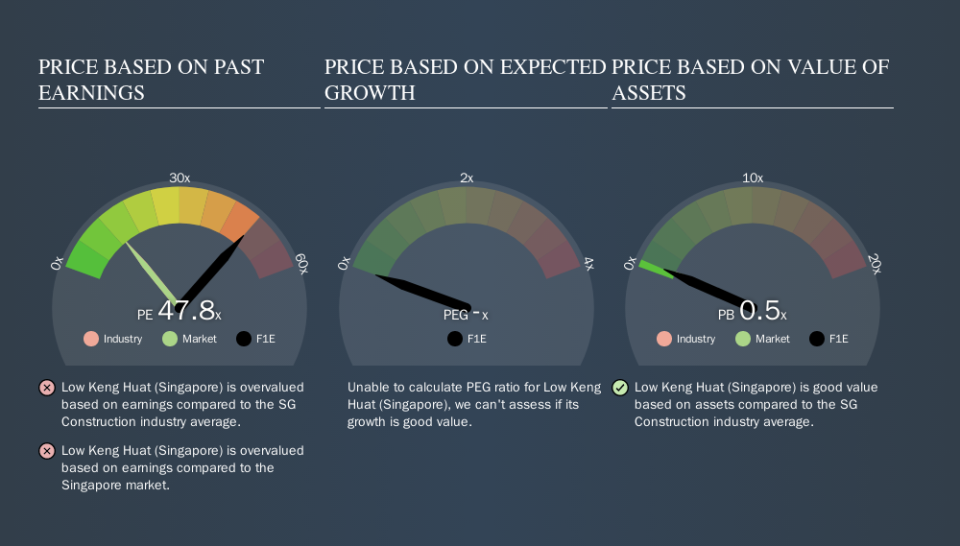Should You Be Tempted To Sell Low Keng Huat (Singapore) Limited (SGX:F1E) Because Of Its P/E Ratio?

The goal of this article is to teach you how to use price to earnings ratios (P/E ratios). We'll apply a basic P/E ratio analysis to Low Keng Huat (Singapore) Limited's (SGX:F1E), to help you decide if the stock is worth further research. What is Low Keng Huat (Singapore)'s P/E ratio? Well, based on the last twelve months it is 47.77. In other words, at today's prices, investors are paying SGD47.77 for every SGD1 in prior year profit.
View our latest analysis for Low Keng Huat (Singapore)
How Do I Calculate A Price To Earnings Ratio?
The formula for price to earnings is:
Price to Earnings Ratio = Share Price ÷ Earnings per Share (EPS)
Or for Low Keng Huat (Singapore):
P/E of 47.77 = SGD0.45 ÷ SGD0.01 (Based on the trailing twelve months to July 2019.)
Is A High Price-to-Earnings Ratio Good?
A higher P/E ratio means that buyers have to pay a higher price for each SGD1 the company has earned over the last year. That isn't a good or a bad thing on its own, but a high P/E means that buyers have a higher opinion of the business's prospects, relative to stocks with a lower P/E.
Does Low Keng Huat (Singapore) Have A Relatively High Or Low P/E For Its Industry?
One good way to get a quick read on what market participants expect of a company is to look at its P/E ratio. The image below shows that Low Keng Huat (Singapore) has a significantly higher P/E than the average (13.3) P/E for companies in the construction industry.
Its relatively high P/E ratio indicates that Low Keng Huat (Singapore) shareholders think it will perform better than other companies in its industry classification. Shareholders are clearly optimistic, but the future is always uncertain. So investors should delve deeper. I like to check if company insiders have been buying or selling.
How Growth Rates Impact P/E Ratios
Companies that shrink earnings per share quickly will rapidly decrease the 'E' in the equation. Therefore, even if you pay a low multiple of earnings now, that multiple will become higher in the future. So while a stock may look cheap based on past earnings, it could be expensive based on future earnings.
Low Keng Huat (Singapore) shrunk earnings per share by 67% over the last year. And over the longer term (5 years) earnings per share have decreased 27% annually. This might lead to muted expectations.
Don't Forget: The P/E Does Not Account For Debt or Bank Deposits
One drawback of using a P/E ratio is that it considers market capitalization, but not the balance sheet. That means it doesn't take debt or cash into account. The exact same company would hypothetically deserve a higher P/E ratio if it had a strong balance sheet, than if it had a weak one with lots of debt, because a cashed up company can spend on growth.
Such expenditure might be good or bad, in the long term, but the point here is that the balance sheet is not reflected by this ratio.
How Does Low Keng Huat (Singapore)'s Debt Impact Its P/E Ratio?
Net debt totals a substantial 201% of Low Keng Huat (Singapore)'s market cap. If you want to compare its P/E ratio to other companies, you must keep in mind that these debt levels would usually warrant a relatively low P/E.
The Bottom Line On Low Keng Huat (Singapore)'s P/E Ratio
Low Keng Huat (Singapore) trades on a P/E ratio of 47.8, which is multiples above its market average of 13.2. With meaningful debt and a lack of recent earnings growth, the market has high expectations that the business will earn more in the future.
Investors have an opportunity when market expectations about a stock are wrong. People often underestimate remarkable growth -- so investors can make money when fast growth is not fully appreciated. Although we don't have analyst forecasts you could get a better understanding of its growth by checking out this more detailed historical graph of earnings, revenue and cash flow.
Of course, you might find a fantastic investment by looking at a few good candidates. So take a peek at this free list of companies with modest (or no) debt, trading on a P/E below 20.
We aim to bring you long-term focused research analysis driven by fundamental data. Note that our analysis may not factor in the latest price-sensitive company announcements or qualitative material.
If you spot an error that warrants correction, please contact the editor at editorial-team@simplywallst.com. This article by Simply Wall St is general in nature. It does not constitute a recommendation to buy or sell any stock, and does not take account of your objectives, or your financial situation. Simply Wall St has no position in the stocks mentioned. Thank you for reading.

